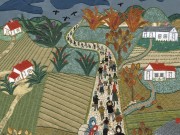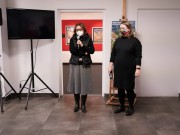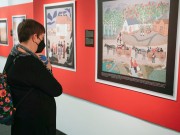exhibition opening: February 18, 2022, 18:00
exhibition open until April 24, 2022 from 10:00 to 17:00 (except Mondays)
tickets: 5 PLN (opening day and Sundays – free of charge)
In 1977, at the age of 50, Esther Nisenthal Krinitz began creating works of fabric art to depict her stories of survival. Trained as a dressmaker but untrained in art, she created a collection of 36 needlework and fabric collage pictures in strong, vivid colors and striking details with a sense of folk-like realism. Meticulously stitched words beneath the pictures provide a narrative. While the pictures are visually pleasing, almost cheerful, a closer examination reveals the stark incongruity between the pastoral surroundings and the human violence, terror, and betrayal that are their subjects.
Although her work has been widely exhibited, Krinitz created her series of pictures simply to pass on her memories to her children. “I had no intention or ever dreamed that they would be exhibited. I only did it for my children, my two daughters,” she said.
This version of the exhibition is an illustrated life story of Esther Nisenthal Krinitz. The presented images are reproductions of exceptional works that have been exhibited in the original version only in the United States so far.
THE STORY OF ESTHER
Esther Nisenthal Krinitz and her sister Mania were the only members of their family, and among the few Jews in their Polish village, to survive the Holocaust.
As a 12-year-old in September 1939, Esther watched German soldiers arrive in her village of Mniszek, near the town of Rachów in the Lublin region of eastern Poland. For the next 3 years, German troops imprisoned Jews as slave laborers and subjected others to random shootings and brutality. On October 15, 1942, the Germans ordered all the Jews to report to a nearby train station.
Esther, by then 15, refused to go. Instead, she and her 13-year-old sister, Mania, went to their father’s friend Stefan, a Polish farmer in a nearby village, hoping he would take them in. But after sheltering them for a couple of days, Stefan told them he could no longer keep them.
Esther then realized that in order to survive, they would have to assume the identities of Polish Catholic farm girls. They eventually came to the village of Grabówka, where Esther found work with an old farmer. Once Soviet Army troops liberated the village in July 1944, and Esther learned that the rest of her family had not survived, Esther joined the Polish People’s Army, under Soviet Army command.
After the war ended in 1945, Esther returned to Poland to get Mania and in 1946, the two of them went to Germany, making their way to a displaced persons camp in the city of Ziegenhain. There, Esther met and married Max Krinitz. The following year, pregnant with their first child, Esther joined Max in Belgium, where he had gone to work while waiting to immigrate to the United States. In June 1949, Esther, Max and their daughter arrived in New York.
Fifty years later, in 1999, Esther returned to Poland for the first time, to show her daughters and grandchildren the places they had seen only in her pictures. Esther died in 2001 at the age of 74.






















